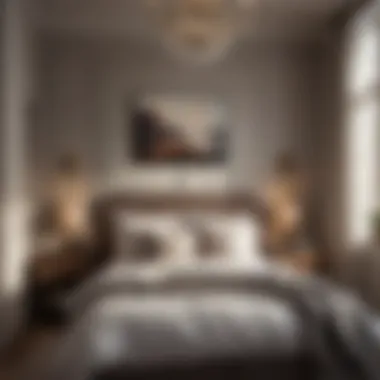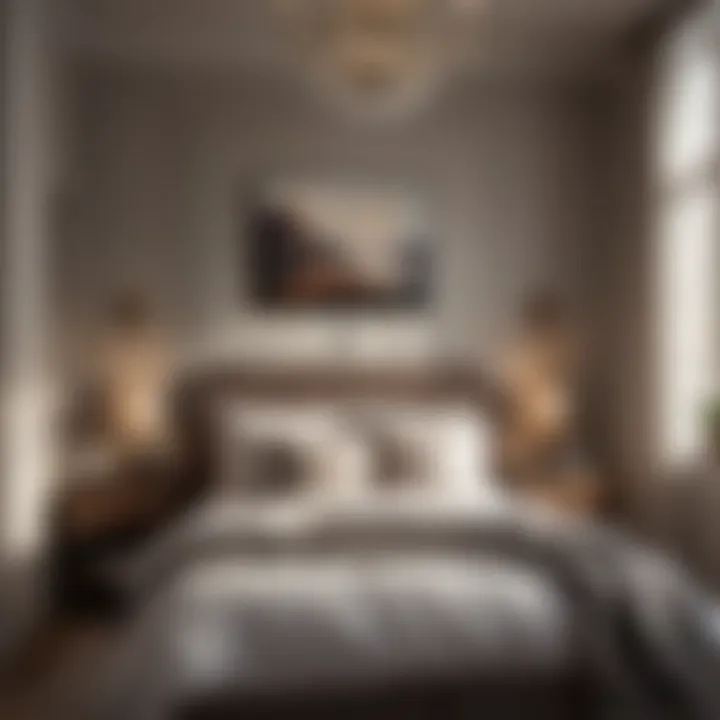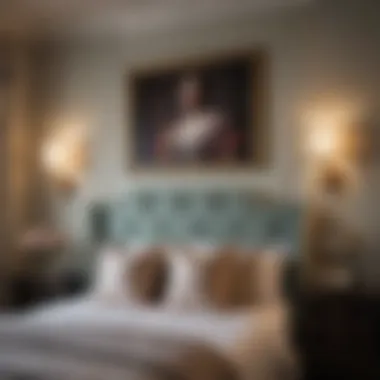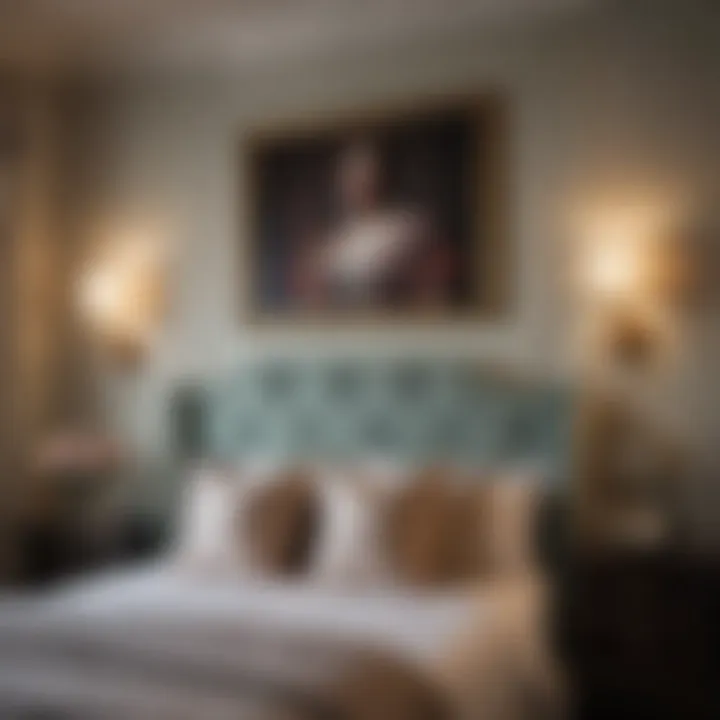Budget-Friendly Guest Bedroom Decorating Tips


Intro
When guests come to visit, the comfort and aesthetics of the spare bedroom can significantly impact their experience. Creating a welcoming environment does not have to mean spending a fortune. Even on a tight budget, thoughtful design choices can make a profound difference. This article provides practical strategies for decorating a guest bedroom cost-effectively. It will cover current trends, visual ideas, and key considerations that ensure both style and functionality.
Current Trends
Color Palettes
The color palette plays a pivotal role in setting the ambiance. For guest bedrooms, soft and neutral tones are gaining popularity. Light grays, beige, and pastel shades create a tranquil atmosphere, inviting relaxation. To add character without overwhelming the senses, consider accent colors. A deep navy or rich emerald can serve as an eye-catching element, perhaps through throw pillows or wall art.
Popular Styles
Minimalist design continues to trend, focusing on simplicity and elegance. Functional furniture is key, emphasizing clean lines. Another prevailing style is bohemian, characterized by a mix of patterns and textures that create a casual yet chic feel. Budget-friendly decorators can choose a hybrid approach, merging styles for a personalized touch. Comfortable bedding and a few carefully selected accessories can enhance the overall look.
Visual Ideas
Gallery of Styled Bedrooms
Inspiration can be found through curated images. A collection of stylish guest bedrooms showcases how various designs can look appealing yet economical. Many designers and homeowners share their transformations on platforms like Instagram and Pinterest. Utilize this resource to gather ideas that align with personal tastes and space constraints.
Before-and-After Transformations
Displaying the journey from ordinary to extraordinary can be motivating. Before-and-after images highlight the impact of simple changes. A fresh coat of paint, swapped-out textiles, or clever furniture arrangement can result in profound transformations. A feature to consider is showcasing these images in a portfolio format, illustrating the effectiveness of budget-minded solutions.
"It's not about how much you spend, but the thought and effort put into creating a lasting impression."
Key Considerations
Assessing priorities is crucial. Here are aspects to focus on:
- Quality over Quantity: Invest in a few high-quality items rather than numerous low-cost alternatives.
- Multi-functional Furniture: Look for pieces that serve multiple purposes, like a daybed that can act as both a couch and a bed.
- Local Thrift Stores: These can be treasure troves for unique decor and furnishings.
Overall, with creativity and planning, a guest bedroom can be transformed without substantial financial investment. Emphasizing thoughtful choices allows for an inviting environment that feels both curated and comfortable.
Understanding Budget Constraints
Understanding budget constraints is pivotal when it comes to decorating a guest bedroom. Budget limitations often shape the decisions made throughout the entire decorating process. Knowing how much to spend not only guides purchasing choices, but also helps avoid unnecessary financial stress.
It is essential to consider the overall expenses related to the room's transformation. This includes furniture, textiles, decor, and even potential renovations. Establishing a clear budget allows for better planning, ensuring that funds are allocated wisely to create a cohesive and inviting space.
Assessing Your Budget
Begin by assessing your financial situation. Take a close look at your total available funds for the guest bedroom project. Write down all necessary expense categories, such as:
- Furniture
- Bedding
- Paint or wallpaper
- Decorative accessories
Additionally, it is important to identify if there are any limitations. Consider what can be repurposed from other areas of your home. This step can reveal potential savings opportunities.
Identify specific amounts you feel comfortable spending in each category. Keeping a detailed record helps maintain focus and prevents overspending.
Setting Realistic Expectations
The next step is to set realistic expectations based on the budget you have. Understand that decorating does not have to mean complete renovation. Small updates can significantly elevate your guest bedroom's appeal.
Acknowledge that achieving magazine-worthy results takes time and possibly more funds. Instead, focus on attainable goals, like fresh linens or a fresh coat of paint. Engage in research to find budget-friendly ideas that suit your style and needs.
Prioritizing Needs Over Wants
When decorating, distinguishing between needs and wants is essential. Needs are fundamental elements necessary for comfort, while wants encompass desirable but non-essential items.
For a guest bedroom, prioritize elements like:
- Comfortable Bedding: Quality mattresses and pillows are fundamental for a positive guest experience.
- Adequate Lighting: Good lighting options ensure space appears welcoming.
- Functional Furniture: This includes items like nightstands or a small desk, if space allows.
Once foundational needs are satisfied, you can assess additional decor elements. Gamify this process by putting a limit on how many decorative items you plan to add. This allows for creativity while keeping costs in check.
"Creating a beautiful guest space does not necessarily mean spending a lot of money; it’s about smart planning and thoughtful choices."
Color Schemes and Themes


Color schemes and themes serve as the foundation for any decorating project, particularly in establishing a welcoming environment for a guest bedroom. Choosing the right colors can influence mood, contribute to a sense of relaxation, and create a cohesive overall aesthetic. Understanding color psychology can lead to a more thoughtful approach to decor. Moreover, a well-planned color palette can harmonize various elements in the room, from furniture to decor items, ensuring that guests feel comfortable and at home.
Choosing a Color Palette
Selecting a color palette sets the tone for the entire room. Neutral shades, like beige, gray, or soft whites, often serve as versatile backgrounds. They allow for flexibility with accent colors, which can vary seasonally or with trends. Additionally, pastel colors, such as muted pinks or blues, offer a calming effect.
When deciding on a palette, consider the existing features in the room, such as natural light and architectural details. A good approach is to pick three colors: one for the walls, one for the furniture, and a third for accent pieces. Tools like color wheels or apps can help visualize combinations and ensure balance. By limiting the palette to a few colors, the room maintains a focused and intentional look, making the decorating process budget-friendly while still being visually appealing.
Creating a Cohesive Look
A cohesive look in a guest bedroom is achievable when all elements work together harmoniously. It starts with continuity in color and style. If the walls are painted in a soft olive, then accents in deep cream or light wood can enhance the theme. Additionally, choosing furniture that aligns with the same aesthetic—be it modern, rustic, or minimalist—helps in layering design elements effectively.
Accessorizing should also follow the established theme. For example, if one opts for a nautical theme, items like striped pillows or seashell decor can complement without overwhelming the room. This consistency avoids distractions and promotes a serene atmosphere, which is what many guests seek in a bedroom.
Using Accent Walls
An accent wall is a practical way to introduce a bold color or pattern without overwhelming the guest bedroom. This style allows for creativity while adhering to a budget since only one wall requires paint or wallpaper. For instance, a vibrant teal or a refreshing green can bring life to an otherwise subdued space.
Choosing the right wall for an accent involves thinking about the room's layout. Walls behind the bed are common choices, drawing attention directly to the focal point.
When opting for wallpaper, consider peel-and-stick options, which provide easy application and removal, suitable for renters or those who regularly change their decor. Accent walls add dimension and invite interest, serving as an effective way to express personality within the budget constraints.
Furniture Selection
Selecting the right furniture is crucial in creating an appealing guest bedroom. The furniture determines the room's functionality and can affect the overall atmosphere. Furniture choices impact not just aesthetics but also comfort and practicality. In a guest bedroom, furniture should accommodate different needs while being stylish. Balancing these aspects can lead to a welcoming space for your visitors.
Evaluating Existing Furniture
Before purchasing new items, assess what furniture you already have. It may often be possible to repurpose or refresh existing pieces. Consider if your current headboard, dresser, or nightstands can serve in the guest room. Evaluate their condition and style against your new decor plans. A bit of paint or new hardware can transform an old dresser into a stunning focal point. This is not only economical but also less wasteful, supporting a more sustainable approach to decorating.
Shopping for Secondhand Finds
Secondhand furniture can be a fantastic solution for budget-friendly decorating. Thrift stores, garage sales, and online marketplaces often have hidden gems. Look for solid pieces that can be easily restored or modified. A unique chair or vintage nightstand can add character to your guest room. Additionally, buying secondhand supports local economies and reduces the demand for new production. Always check the quality and condition thoroughly. This can save you money while enriching your decor with one-of-a-kind elements.
Understanding Multi-Functional Furniture
In limited spaces, multi-functional furniture is essential. Items that can serve more than one purpose, such as a sofa bed or an ottoman with storage, maximize utility without overcrowding the room. This allows you to create a versatile space that caters to your guests’ needs. A well-chosen piece not only enhances functionality but also contributes stylistically. Consider adding a small desk that can be used for work or as a vanity. Look for designs that combine style with versatility, as they can elevate the entire guest experience.
Bedding and Linens
Bedding and linens play a critical role in defining the comfort and aesthetic of a guest bedroom. When hosting visitors, it is essential that the space feels inviting and restful. The right bedding can not only contribute to the overall theme of the room but also ensure that your guests have a pleasant experience. Hence, this section will delve into the selection process for comfortable bedding, the art of mixing textures and patterns, and exploring affordable linen alternatives.
Selecting Comfortable Bedding
It is important to choose bedding that promotes good sleep. Consider factors like material, thread count, and overall feel when selecting sheets and comforters. Opt for cotton or linen fabrics as they are breathable and gentle on the skin. Additionally, a thread count between 300 and 600 can provide a balance of softness and durability. Remember to consider the seasons as well; lighter fabrics are ideal for warmer months, while heavier blankets work best in winter.
A well-made bed makes a welcoming statement to guests.
Investing in quality pillows is also crucial. Find pillows that offer support and comfort, keeping in mind personal preferences. Some guests may prefer firm support, while others enjoy a softer sleep surface. It may be worthwhile to provide a variety of options. This way, guests can select what feels most comfortable to them.
Mixing Textures and Patterns
Incorporating various textures and patterns can enhance the visual interest of the guest bedroom. Consider using a combination of different textile materials like velvet, cotton, or linen. This diversity adds depth and richness to the bedding ensemble. Mixing patterns, such as stripes, florals, or geometric designs, can also create a dynamic look without overwhelming the senses.
To harmonize these elements, select a unifying color palette. This approach ensures that even with various styles, the overall appearance remains cohesive. For example, if a floral sheet set is chosen, pair it with solid-colored throw pillows in complementary shades to balance the patterns.
Affordable Linen Alternatives
Budget constraints should not hinder your ability to create a stylish and comfortable guest bedroom. There are several affordable linen alternatives that do not compromise on quality. Look for brands that offer discounted or clearance items, as they often have excellent deals on high-quality sheets and comforters.
Another option is to shop for linens at discount retailers or second-hand stores. Many times, you can find gently used or even new products at a fraction of the retail price. Online platforms like Facebook Marketplace or local business groups on platforms like Reddit can also be useful for locating good-quality bedding.
Finally, consider purchasing basic sheets and adding decorative elements, like quilted throws or patterned pillow covers, that you can switch out seasonally. This method enhances versatility and allows for creativity in your guest bedroom design, ensuring it remains fresh and inviting.
Decorative Elements
Decorative elements serve as the finishing touches in a guest bedroom, providing a level of warmth and personality that can make guests feel more welcome. They are essential because they transform a simple space into a visually appealing area that reflects your taste while also considering your guests' comfort. When done thoughtfully, these elements can elevate the ambiance of the room without requiring considerable investment.
Incorporating Art and Prints


Art and prints can significantly enhance the aesthetics of a guest bedroom. They add character and may spark conversations among guests. Choose pieces that are not overly personal but still resonate with the overall theme of the room. For example, landscape prints or abstract art in soothing colors can create a relaxing atmosphere.
Consider framing prints in affordable, yet stylish frames. Local thrift stores or online platforms like Facebook Marketplace often have budget-friendly options. Mixing and matching different sizes and styles of frames can add an eclectic feel. Additionally, arrangement is key; a gallery wall can make a bold statement without taking up much space.
Remember, art should enhance the room’s atmosphere, not overwhelm it.
Utilizing Plants and Greenery
Plants bring life into any room. They improve air quality and generate a sense of calm, which is especially important in a guest space. Select low-maintenance plants like snake plants or pothos that can thrive with minimal care. These choices are aesthetically pleasing and cater to various tastes.
Placing plants in decorative pots can be an effective way to tie different elements of the room together. For instance, a large potted plant in a corner can serve as a focal point, while smaller plants on bedside tables can evoke coziness. Refrain from over-cluttering; a few strategically placed plants can often do more than multiple arrangements.
DIY Decor Projects
Engaging in DIY decor projects not only adds a personal touch to the guest bedroom, but also keeps costs low. Simple crafts such as creating your own wall art, painting a piece of furniture, or sewing throw pillows can make a significant impact.
Consider using materials you already have around the house. Old fabric can become a lovely accent pillow, and reclaimed wood can transform into rustic wall decor. If you feel adventurous, a simple macro photography project can result in unique wall art at minimal expense.
The satisfaction of creating something yourself can enhance the overall atmosphere of the room. Furthermore, these projects often allow for more creativity and personal expression, making the space distinctive. In the end, what you put into the room can reflect the thoughtfulness of your hosting, creating a memorable experience for your guests.
In summary, decorative elements play a vital role in crafting a pleasing and inviting guest bedroom. Through careful selection of art, thoughtful incorporation of plants, and engaging in manageable DIY projects, anyone can achieve a beautifully decorated room without surpassing a budget.
Lighting Considerations
Lighting is a critical aspect of decorating a guest bedroom, often overlooked in budget discussions. The appropriate lighting enhances the room’s functionality and sets the mood, making the space feel more inviting. Thoughtful lighting can highlight design elements, create an atmosphere of comfort, and influence the guests’ overall experience. With a well-planned approach to lighting, it is possible to achieve aesthetic appeal without significant expenditure.
Natural Light vs. Artificial Light
Utilizing natural light can transform a room, providing a sense of openness and vitality. Consider positioning mirrors to reflect windows, which can help amplify sunlight and create a brighter atmosphere. Ideally, guest bedrooms should maximize their exposure to natural light throughout the day. Large windows or sheer curtains allow light to flow freely while ensuring privacy.
However, relying solely on natural light is not practical during evenings or cloudy days. This is where artificial light comes into play. Layering different types of artificial lighting is essential to ensure flexibility in ambiance and functionality.
Affordable Lighting Options
Finding budget-friendly lighting does not require compromising on style. Consider the following options:
- LED Bulbs: They are energy-efficient and long-lasting. Choosing warm tones can create a cozy ambiance.
- Table Lamps: Affordable and versatile, these can be used on nightstands or desks to enhance warm lighting.
- String Lights: They add a whimsical touch and can be used creatively around the room.
- DIY Fixtures: Repurposing old materials to create unique light fixtures can save money and add character.
Exploring local thrift stores or online marketplaces can reveal many hidden gems at low costs. Incorporating these options can ensure the space is well-lit without overspending.
Layering Lighting for Ambiance
Creating layers of light involves combining various lighting types to build depth and atmosphere in the guest bedroom. Including ambient, task, and accent lighting is advisable.
- Ambient Lighting: This is the main source of light in the room, like ceiling fixtures. It establishes an overall brightness.
- Task Lighting: Use reading lamps or focused light near seating areas for specific functions. This ensures that guests can comfortably read or engage in activities without straining their eyes.
- Accent Lighting: Accent lights can highlight decor elements like artwork or plants. This adds interest and character to the room.
By strategically layering these light sources, the guest bedroom not only remains functional, but it also becomes a welcoming space that resonates with warmth and comfort.
Important Note: Remember to consider the dimming options for different fixtures to adapt to various situations, ensuring both energy efficiency and mood adaptability.
Space Optimization
Maximizing Small Spaces
Maximizing small spaces requires creativity and strategic planning. When dealing with limited room dimensions, it's essential to choose furniture that does not overwhelm the space. Opt for pieces that offer multiple functions, such as a bed with built-in drawers or a sleeper sofa. Additionally, consider wall-mounted shelves instead of bulky furniture to keep the floor area open.
Mirrors can also serve as a powerful tool in small spaces. Placing a mirror across from a window can reflect light and create the illusion of depth. Furthermore, light-colored walls can enhance the sense of space, making the room feel airy and expansive. Selecting a few key pieces of decor, rather than crowding the area with knick-knacks, will help in maintaining a clean and organized appearance.
Storage Solutions on a Budget
Finding effective and budget-friendly storage solutions can greatly enhance the functionality of a guest bedroom. Start by assessing your storage needs. Consider using under-bed storage boxes or baskets that can easily slide beneath the bed frame. This method keeps essential items out of sight yet easily accessible.
Another idea involves using furniture that doubles as storage. For instance, ottomans or benches with hidden compartments can provide additional seating while offering storage for extra blankets or pillows. Utilize vertical storage solutions, such as tall bookcases or wall organizers, to take advantage of the room’s height without occupying too much floor space.
Creating an Inviting Layout
Creating an inviting layout is key to ensuring your guest bedroom feels welcoming. Start by defining focused areas within the room. A cozy reading nook with a chair or small bench and a lamp can encourage relaxation. The bed should ideally be the focal point and positioned to maximize natural light if possible.
Ensure there is enough space to move around without obstruction. Consider leaving at least 24 inches of walking space around the bed. Small side tables with lamps should be beside the bed to provide functionality without crowding.


Incorporating personal touches, such as framed photos or artwork, adds warmth to the layout. Arrange the elements in a way that encourages conversation and connection. This strategy allows guests to feel more at home, enhancing their overall comfort during their stay.
Finishing Touches
Finishing touches are crucial in transforming a guest bedroom from a basic space into a cozy retreat. These elements not only enhance the visual appeal but also provide comfort and a sense of welcome. When decorating, it is easy to focus on big changes like furniture or paint, but it is the small details that often leave a lasting impression on guests.
Accessorizing Thoughtfully
Accessorizing with intention can elevate the room's aesthetic without requiring significant financial investment. Start by selecting items that reflect the overall theme and color palette of the room. Consider adding decorative pillows with different textures or patterns. They can imply comfort while being visually appealing. Choose throw blankets that invite guests to snuggle in, especially during colder months.
Furthermore, add bedside tables with lamps that match the room's design. These lamps not only provide necessary light but also become statement pieces. Uplifting clips and coasters can also introduce character while serving practical purposes. Ensure that accessories don’t clutter but rather enhance the space. Less is often more.
Personalizing with Memories
Personal touches communicate care and thoughtfulness. Including family photos in stylish frames can create a homely vibe. Choose frames that complement the bedroom’s style, such as rustic wood frames for a farmhouse look or sleek metallic ones for a modern feel.
You might also display travel souvenirs or pieces from local artisans. Incorporating these items can spark conversations and make guests feel at home. They reinforce the identity of the space while showcasing your personal interests. Remember to keep it tasteful; too many items can overwhelm the senses.
Creating a Welcoming Atmosphere
The atmosphere of a guest bedroom can significantly impact a visitor's overall experience. Start by ensuring the room smells fresh and inviting. A simple solution could be scented candles or essential oil diffusers. Choose soft fragrances like lavender or vanilla that promote relaxation.
Lighting plays a vital role in this aspect as well. Natural light is always ideal, so maximize it by using light, airy curtains. If there’s limited natural light, invest in soft artificial lighting to create a mellow ambiance. Avoid harsh, overhead lights. Instead, consider warm LED bulbs that give off a soft glow.
Finally, ensure the environment feels safe and inviting. A small welcome note or a bowl of snacks can go a long way in making guests feel valued.
"Finishing touches serve as the frame for your larger design initiatives, creating cohesion and enhancing the emotional connection to the space."
Besides these, maintaining a consistent theme throughout assures a harmonious living space. This ultimately contributes to guest satisfaction as well as your enjoyment of the room, making it a worthwhile investment for any homeowner.
Maintenance and Upkeep
Maintaining a guest bedroom is pivotal for ensuring it remains an inviting retreat for visitors. Without regular upkeep, even the most stunning spaces can lose their charm over time. In this section, we will explore three vital aspects of maintenance: establishing regular cleaning routines, sustaining decor, and updating seasonal elements. Each component plays a crucial role in preserving the aesthetics and functionality of the room.
Regular Cleaning Routines
To keep a guest bedroom looking its best, a consistent cleaning schedule is essential. A tailored cleaning routine helps avoid the buildup of dust and allergens, which can impact the comfort of your guests. Here are some practical steps to consider:
- Dust Surfaces Regularly: Ensure shelves, nightstands, and light fixtures are free of dust.
- Wash Bedding Frequently: Clean linens not only enhance the look of the bed but promote hygiene.
- Vacuum and Mop Floors: Regular vacuuming minimizes dirt accumulation, while mopping adds that fresh feel.
Creating a checklist can simplify this process, allowing you to track what needs to be done weekly and monthly. Consider involving family members in the cleaning to foster a sense of teamwork.
Sustaining the Decor
Keeping the decor fresh and appealing requires ongoing attention. Elements like wall art, decorative pillows, and curtains can wear down or become outdated over time. Here’s how to sustain the decorative aspects effectively:
- Inspect Regularly: Look for any wear and tear on linens, artwork frames, or furniture surfaces.
- Update Accents: Swap out throw pillows or rugs seasonally for a quick refresh without a full overhaul.
- Keep it Minimal: Less clutter makes maintenance easier and helps guests feel more comfortable.
Taking these steps not only preserves the design but also contributes to a welcoming atmosphere.
Updating Seasonal Elements
As seasons change, so do feelings and aesthetics. Updating certain elements can keep the room looking fresh and inviting. Consider the following:
- Seasonal Linens: Use lighter fabrics in summer and heavier ones in winter.
- Seasonal Decor: Incorporate seasonal flowers or themed decor items that reflect the time of year.
- Aroma and Ambiance: Adjust scents with candles or air fresheners that align with the seasons.
"Updating seasonal elements not only beautifies the space but also creates a more personalized experience for guests."
The End
Final Thoughts
Reflecting on Your Design Choices
Reflecting on your design choices allows you to assess how each element aligns with your goals for the space. Consider functionality—does the selected furniture serve multiple purposes? Also, evaluate the color scheme. Does it create the desired mood? A cohesive design minimizes clutter and confusion. Reviewing these aspects can help you recognize areas of improvement or affirmation of your creativity. Each decision influences how the room feels and functions, so take the time to reflect. Whether you are deeply satisfied or see room for enhancements, this pondering helps create a space that lives up to your vision.
Encouraging Feedback from Guests
Encouraging feedback from your guests is essential. It provides insights that can lead to meaningful adjustments. After their stay, ask what they liked or what could improve their experience. This practice can inform future decorating endeavors and make your guest space more accommodating. Positive feedback validates your choices and helps bolster the inviting nature of your design. Constructive responses may lead to specific recommendations, like enhancing lighting or adding particular comforts. Guest feedback is invaluable in this regard.
Adapting for Future Changes
Adapting for future changes prepares your guest bedroom for continual improvement. As trends in design and personal preferences evolve, it’s important to stay flexible. This could mean updating bedding styles, rearranging furniture, or even a fresh coat of paint. Keeping the space adaptable allows you to refresh the environment without incurring high expenses.
Moreover, consider the shifting needs of your guests over time. A space that meets various age groups or stay durations might benefit from adjustments in layout or decor. Being proactive can transform your guest room into a space that feels comfortable and welcoming for all, allowing you to keep your decorating vision alive as your tastes and circumstances change.



